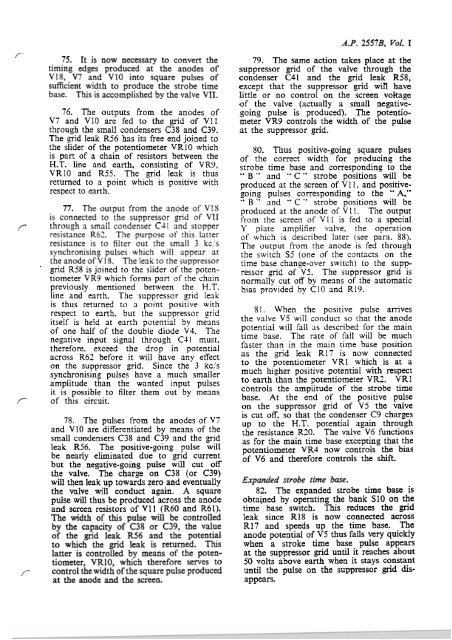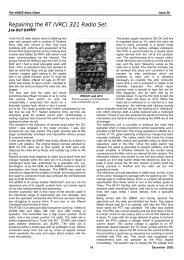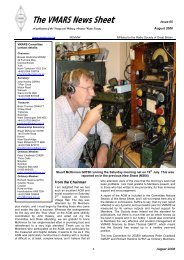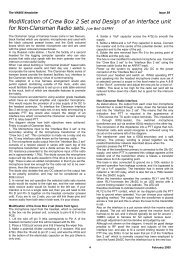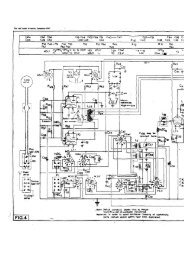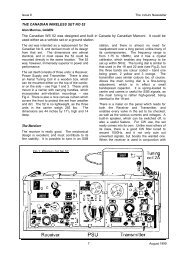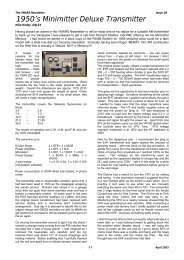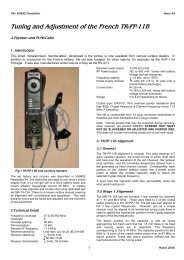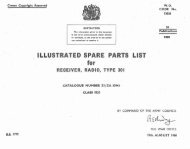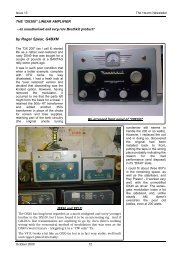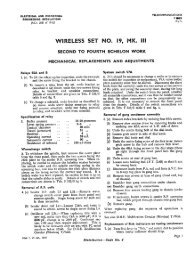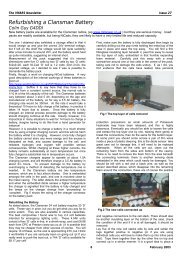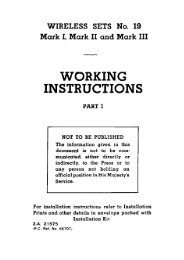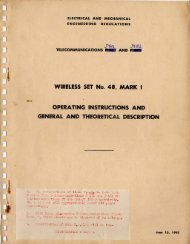2115_ Gee_MkII_Tropical.pdf - VMARSmanuals
2115_ Gee_MkII_Tropical.pdf - VMARSmanuals
2115_ Gee_MkII_Tropical.pdf - VMARSmanuals
Create successful ePaper yourself
Turn your PDF publications into a flip-book with our unique Google optimized e-Paper software.
75. It is now necessary to convert the<br />
timing edges produced at the anodes of<br />
V18, V7 and V10 into square pulses of<br />
sufficient width to produce the strobe time<br />
base. This is accomplished by the valve VII.<br />
76. The outputs from the anodes of<br />
V7 and V10 are fed to the grid of V11<br />
through the small condensers C38 and C39.<br />
The grid leak R56 has its free end joined to<br />
the slider of the potentiometer VRlO which<br />
is part of a chain of resistors between the<br />
H.T. line and earth, consisting of VR9,<br />
VRlO and R55. The grid leak is thus<br />
returned to a point which is positive with<br />
respect to earth.<br />
77. The output from the anode of V18<br />
is connected to the suppressor grid of VII<br />
,r through a small condenser C4l and stopper<br />
resistance R62. Tlie purpose of this latter<br />
resistance is to filter out the small 3 kc/s<br />
synchronising pulses which will appear at<br />
the anode of V 18. The leak to the suppressor<br />
'<br />
grid R58 is joined to the slider of the potentiometer<br />
VR9 which forms part of the chain<br />
previously mentioned between the H.T.<br />
line and earth. The suppressor grid leak<br />
is thus returned to a point positive with<br />
respect to earth. but the suppressor srid<br />
itself is held at earth potential by means<br />
of one half of the double diode V4. The<br />
negative input signal through C11 must.<br />
therefore, exceed the drop in potential<br />
across R62 before it will have any effect<br />
on the suppressor grid. Since the 3 kc/s<br />
synchronising pulses have a much smaller<br />
amplitude than the wanted input pulses<br />
it is possible to filter them out by means<br />
7 of this circuit.<br />
r<br />
78. The pulses from the anodes of V7<br />
and V10 are differentiated by means of the<br />
small condensers C38 and C39 and the grid<br />
leak Rj6. The positive-going pulse wiil<br />
be nearly eliminated due to grid current<br />
but the negative-going pulse will cut off<br />
the valve. The charge on C38 (or C39)<br />
will then leak up towards zero and eventually<br />
the valve will conduct again. A square<br />
pulse will thus be produced across the anode<br />
and screen resistors of V11 (R60 and R61).<br />
The width of this pulse wih be controlleh<br />
by the capacity of C38 or C39, the value<br />
of the grid leak R56 and the potential<br />
to which the grid leak is returned. This<br />
latter is controlled by means of the potentiometer,<br />
VR10, which therefore serves to<br />
control the width of the square pulse produced<br />
at the anode and the screen.<br />
A.P. 2557B, Vol. I<br />
79. The same action takes place at the<br />
suppressor grid of the valve through the<br />
condenser C41 and the grid leak R58,<br />
except that the suppressor grid will have<br />
little or no control on the screen voltage<br />
of the valve (actually a small negativegoing<br />
pulse is produced). The potentiometer<br />
VR9 controls the width of the pulse<br />
at the suppressor grid.<br />
80. Thus positive-going square pulses<br />
of the correct width for producing the<br />
strobe time base and corresponding to the<br />
" B " and " C " strobe positions will be<br />
produced at the screen of V11, and positivegoing<br />
pulses corresponding to the " A,"<br />
" B " and " C " strobe positions will be<br />
produced at the anode of V 11.<br />
The output<br />
from the screen of VI 1 is fed to a special<br />
Y plate ampiifier valve. the operation<br />
of which is described later (see para. 85).<br />
The output from the anode is fed through<br />
the switch SS (one of the contacts on the<br />
time base change-over switch) to the suppressor<br />
grid of V5. The suppressor grid is<br />
normally cut off by means of the automatic<br />
bias provided by C10 and R19.<br />
81. When the positive pulse arrives<br />
the valve V5 will conduct so that the anode<br />
potential will fall as described for the main<br />
time base. The rate of fall will be much<br />
faster than in the main time base position<br />
as the grid leak R17 is now connected<br />
to the potentiometer VRI which is at a<br />
much higher positive potential with respect<br />
to earth than the potentiometer VR2. VRI<br />
controls the amplitude of the strobe time<br />
base. At the end of the positive pulse<br />
on the suppressor grid of V5 the valve<br />
is cut off, so that the condenser C9 charges<br />
up to the H.T. potential again through<br />
the resistance R20. The valve V6 functions<br />
as for the main time base excepting that the<br />
potentiometer VR3 now controis the bias<br />
of V6 and therefore controis the shift.<br />
Expanded strobe time base.<br />
82. The expanded strobe time base is<br />
obtained by operating the bank SlO on the.<br />
time base switch. This reduces the grid<br />
leak since R18 is now co~ected across<br />
R17 and speeds up the time base. The<br />
anode potential of V5 thus falls very quickly<br />
when a stroke time base pulse appears<br />
at the suppressor grid until it reaches about<br />
50 volts above earth when it stays constant<br />
until the pulse on the suppressor grid disappears.


